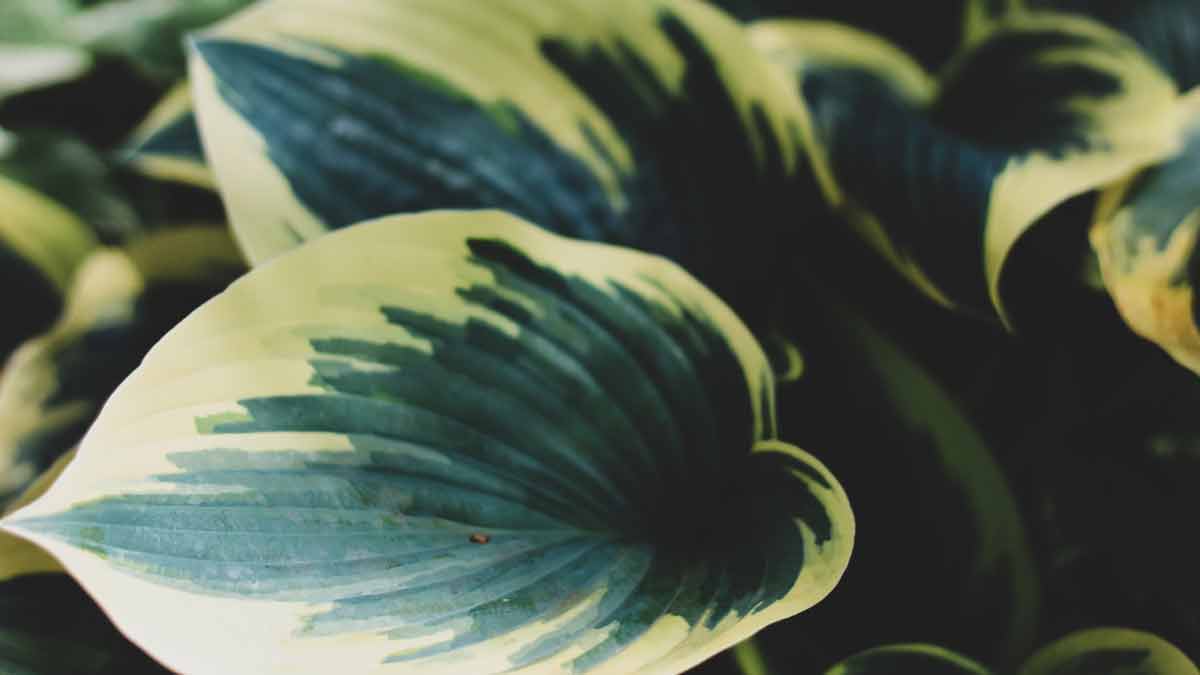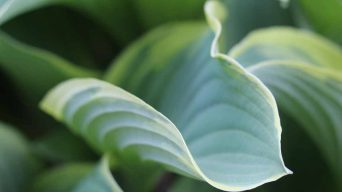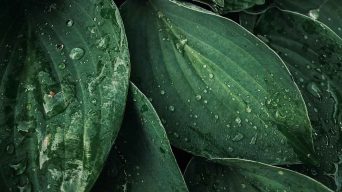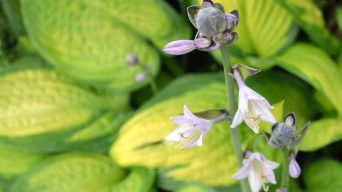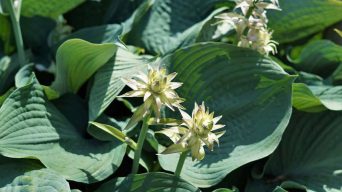The most common reason for browning in hosta leaves is sunburn. Hostas prefer shade, and too much sunlight exposure can cause leaves to turn brown. Other causes include temperatures that are too cold or hot, drought stress, low humidity, pest damage, fungal infections, excessive fertilizing, and water quality.
Hosta plants are beloved by gardeners for their large, showy leaves and easy-care nature. But sometimes, hostas can develop brown patches or entire leaves that turn brown and die.
If your hosta leaves are turning brown, don’t despair! In most cases, this problem is relatively easy to fix.
There are a few different reasons why hosta leaves might turn brown, and to solve the problem, you’ll need to figure out which one is affecting your plant.
This article will cover the most common causes of brown hosta leaves and what you can do to fix the problem.
Why Do Hosta Leaves Turn Brown and What Can You Do About It
There are a few different reasons why hosta leaves might turn brown, and to solve the problem, you’ll need to figure out which one is affecting your plant.
Here are 11 possible causes of brown hosta leaves, along with what you can do to fix the problem.
Too Little Light
Light plays several critical roles in plant growth. Not only does it provide the energy needed for photosynthesis, but it also helps guide plant development, affecting leaf shape and color.
However, too little light can cause problems as well. If a hosta receives too little sunlight, its leaves will often turn brown and wither away. This is because plants need light not only to develop their overall form and function but also to produce chlorophyll. This pigment gives plants their green color.
Hosta plants will have trouble producing enough chlorophyll without adequate light to keep their leaves healthy and vibrant.
Also, as hostas develop in areas with limited sun exposure, they may become unusually thin or elongated to maximize their exposure to light.
How To Fix a Hosta With Too Little Light
The best way to fix a hosta that’s not getting enough light is to move it to a sunnier location.
Although hosta plants are shade-loving, they still need some sun to thrive. Aim for a spot with 4-6 hours of indirect light daily.
An east- or west-facing windowsill or an area beneath a tree that gets dappled sunlight would be a good option.
If you can’t move your hosta to a sunnier location, try increasing the amount of artificial light it’s getting with grow lights.
Too Much Sunlight
Sunlight is essential for plant growth since it helps to provide energy and fuel vital biological processes in plants.
However, too much direct sunlight can damage plant life, especially if the sun is intense.
One type of plant that is particularly sensitive to too much sunlight is the hosta. This is because these garden perennials’ long, broad leaves cannot efficiently photosynthesize when overexposed to direct sunlight.
Instead, this excessive sun exposure can cause the leaves of a hosta plant to turn brown or take on a discolored appearance.
How To Fix a Browning Hosta From Too Much Sunlight
If you think that too much sunlight is causing the leaves of your hosta to brown, the best solution is to move it to a shadier location.
Hostas thrive in shady areas and do not need direct sunlight to grow. Too much sun can be harmful to these plants.
A spot beneath a tree or in an east- or north-facing garden would be ideal. If you can’t move your hosta, try covering it with a light cloth or shade screen to protect it from the sun’s rays.
Underwatering
Underwatering is one of the primary causes of browning hosta leaves. This is because when plants are not getting enough water, they start to dry out, and their cells become stressed and break down.
When this happens, the leaves of a hosta plant will begin to turn brown and wither.
Also, if a hosta lacks water, its leaves may become curled or brittle. The plant may also start to produce smaller leaves than usual.
How To Fix an Underwatered Hosta
To remedy an underwatering issue, you should first increase the frequency or duration of your watering sessions, ensuring that no part of the soil stays overly dry for extended periods.
You can also add some extra organic matter or soil amendments to help retain moisture in the soil.
Finally, if none of these actions are affecting your hostas, you may need to re-evaluate your watering practices by installing a drip irrigation system or conducting regular tests on your soil to measure its moisture levels.
Overwatering
One of the most common causes of brown hosta leaves is overwatering.
When the soil around a hosta plant becomes too saturated with water, it can suffocate the roots and cause them to become damaged or even rot. This leads to nutrient deficiencies in the plants, damaging the hosta foliage and causing it to turn brown or yellow.
Additionally, overwatering often increases fungal growth around the base of a hosta plant. These fungi can further damage the roots and lead to browning leaves.
How To Fix Brown Hosta Leaves Caused By Overwatering
If you think overwatering is the cause of brown hosta leaves on your plant, the solution is simple: water less often!
Allow the soil around your hosta plant to dry out completely between waterings. Hosta plants need to be watered deeply but infrequently.
Water once a week or so, depending on the weather and soil conditions. In hot, dry weather, you may need to water more frequently.
If your hosta plant is in a pot, check the drainage holes to ensure they are not blocked. This will help ensure that excess water can drain from the roots and avoid overwatering your hosta.
Too Little Humidity
When the air around your garden is too dry, it can cause problems for your hosta plants. If humidity levels drop too low, the leaves of these plants will lose moisture and turn crisp and brown.
Hostas need a humid environment to thrive, so if the air around them is too dry, it can cause the leaves to turn brown and eventually die.
The ideal humidity level for hostas is between 50% and 60%.
How To Fix Hosta Leaves Turning Brown Due To Low Humidity
You can do a few simple things to combat this problem and restore moisture to your plants.
One option is regularly misting your plants with a hose or spray bottle. This will help increase humidity levels and keep the leaves hydrated.
Another option is to use mulch around your hostas, which will also help retain moisture in the soil and prevent evaporation.
Finally, you can also try grouping your hostas, as they will create a more humid microclimate than the surrounding air.
Pest Infestation
Many factors can cause hosta leaves to turn brown, including pests and environmental conditions. One of the most common causes is the presence of certain types of insects and mites.
These tiny pests feed on the leaves of hosta plants, extracting nutrients and moisture from them to survive. This process can weaken and damage the leaves, causing them to be dry and brown.
Some pests also carry diseases that can infect a hosta plant and cause the leaves to turn brown or yellow.
Common pests that affect hostas include slugs, snails, aphids, spider mites, and scale insects.
How To Fix Leaf Browning Caused By Pests
If you think pests are to blame for the brown leaves on your hosta plant, you can do a few things to eliminate them.
One option is to pick the pests off by hand and dispose of them. This is often the most effective method for getting rid of small infestations.
Another option is to use a garden hose to blast the pests off your plant. This will also help remove any eggs or larvae that are present.
If the infestation is severe, you may need to use a pesticide to eliminate the pests. You can use a natural pesticide, such as neem oil, or a chemical pesticide.
Whatever method you choose, follow the instructions carefully to avoid harming your hosta plant.
Diseases
Many diseases can affect hostas, causing brown spots on the leaves. The most common include crown rot, rust, and root rot.
These diseases are caused by fungi or bacteria that infect the plant leaves. They can spread quickly and cause extensive damage if not treated properly.
Diseases are commonly spread by contact with infected plants or garden tools. Water droplets can also spread them, so it’s important to avoid wetting the leaves of your hosta plant when watering.
How To Fix Hosta Leaf Browning Caused By Disease
You can do a few things to treat diseases and prevent them from spreading.
One option is to remove any infected leaves from the plant. This will help stop the fungal disease from spreading and allow the plant to focus its energy on healthy growth.
Another option is to treat the plant with a fungicide or bactericide. These products are available at most garden stores and can help kill the pathogens causing the disease.
Natural treatments, such as baking soda or hydrogen peroxide, can also be effective at treating diseases.
Whatever method you choose, follow the instructions carefully to avoid harming your hosta plant.
Temperature Stress
Temperature stress is one factor that can cause hosta plants to turn brown. In particular, when the temperature is too hot or too cold for a prolonged period, the leaves can wilt and eventually die.
This occurs because temperature stress disrupts the normal functioning of the plant’s metabolism, preventing it from acquiring enough water and nutrients from the soil. It makes it more susceptible to other environmental threats.
Additionally, extreme heat can lead to cell damage and fluid loss, weakening the hosta and making it highly vulnerable to disease or insect infestation.
How To Fix Hosta Leaves Turning Brown Due To Temperature Stress
You can do a few things to protect your hosta plant from temperature stress.
Make sure to plant your hosta in an area that receives partial shade. This will help protect the plant from the sun’s intense heat and prevent the hosta leaves from scorching.
You can also provide additional protection from the heat by covering the plant with a light cloth or planting it in a pot that can be moved indoors if necessary.
In the winter, mulch your hosta plant to insulate the roots and protect them from the cold. You can also wrap the plant in burlap or place it in a pot that can be brought indoors if necessary.
Whatever method you choose, remove the plant from its protective covering when the temperature returns to normal to avoid overheating.
Nutrient Deficiencies
Nutrient deficiencies are another common cause of hosta leaves turning brown. The most common nutrients that hostas need are nitrogen, phosphorus, and potassium. These nutrients are essential for the plant to grow properly and stay healthy.
If a hosta lacks one or more of these nutrients, it will show symptoms such as yellowing leaves, stunted growth, and poor flowering. In severe cases, the leaves may turn brown and die.
How To Fix a Nutrient Deficiency in Hostas
The best way to fix nutrient deficiencies is to fertilize the plant. This will give the plant the necessary nutrients to grow properly and stay healthy.
You can use a slow-release fertilizer that will last for several months or an organic fertilizer that will need to be applied more often.
Use a balanced fertilizer that contains nitrogen, phosphorus, and potassium in equal proportions.
Fertilize once a month during the growing season and apply a layer of mulch around the base of the plant to help retain moisture and prevent nutrient loss.
Overfertilization
While it’s important to fertilize your hosta plant to ensure it gets the nutrients it needs, it’s also possible to overfertilize it. This can happen if you use too much fertilizer or apply it too often.
When a plant is overfertilized, the excess nutrients can build up in the soil and start to burn the roots of the plant. This can cause the hosta leaves to turn yellow and brown.
How To Fix Overfertilization in Hostas
If you think your plant has been overfertilized, stop fertilizing it immediately. If the leaves are already turning brown, you can try to save the plant by watering it deeply to dilute the fertilizer and flush it out of the soil.
You can also try to remove the affected leaves if they are still attached to the plant. Once the plant has recovered, be sure to fertilize it only as often as needed and use a light hand when applying fertilizer.
Water Quality
The water you use to water your hosta plant can significantly impact the health and vitality of your hosta plants. Specifically, watering with hard water or chlorine-tainted water can cause hosta leaves to turn brown or wilt.
These harsh chemicals can damage or disrupt essential plant cell processes. As a result, the plant may not be able to properly take up water and nutrients, which can cause the leaves to turn brown and eventually die.
How To Fix Water Quality Issues in Hostas
If you suspect that the water you’re using to water your hosta plants is causing leaf browning, you can do a few things to fix the problem.
Try watering your plants with rainwater or distilled water instead of tap water. This will help to remove any chemicals or minerals that might be causing damage to the plant.
Be sure to flush out your plant’s potting mix every few months to remove any build-up of chemicals or minerals that might be harmful to the plant.
Final Thoughts
Hosta leaves turning brown can be a sign of several problems, from disease to pests to environmental stressors.
By taking a closer look at the leaves, you can often identify the cause of the problem and take steps to fix it.
Your hosta plant will soon look green and healthy with proper care.

